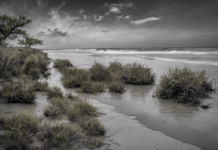Introduction
Plane mirrors are often encountered in our daily lives, from the mirror we use to see ourselves in the morning to the mirrors in cars and even in scientific experiments. The images produced by plane mirrors have some distinct characteristics that set them apart from other types of mirrors. Understanding these characteristics can help in applications ranging from designing optical instruments to understanding the physics behind reflection.
Reflection in Plane Mirrors
When light rays strike a plane mirror, they are reflected according to the law of reflection, which states that the angle of incidence is equal to the angle of reflection. This means that the image seen in a plane mirror is a virtual image, as the light rays do not actually converge at the location of the image but appear to diverge from behind the mirror.
1. Virtual Image
The most significant characteristic of an image formed by a plane mirror is that it is virtual. This means that the image appears to be behind the mirror at a distance equal to the object’s distance from the mirror. No light actually converges at the position of the image; instead, our brain perceives the light rays as if they are coming from the virtual image.
2. Laterally Inverted
Another important characteristic of images formed by plane mirrors is that they are laterally inverted. This means that the left and right sides of the object will appear swapped in the mirror image. For example, if you raise your right hand in front of a mirror, it will appear as if your left hand is raised in the mirror image.
3. Equal Size
Images formed by plane mirrors are the same size as the object. This is because each point on the object is at an equal distance from the mirror as its corresponding point in the image. As a result, the image appears to be the same size as the object, with no distortion in size.
4. Distance from Mirror
The distance between the object and the mirror is equal to the distance between the mirror and the virtual image. This characteristic is crucial for applications such as periscopes or rearview mirrors, where the position of the image needs to be precisely determined.
5. Infinite Images
When you look at an object in a plane mirror, you may notice an interesting feature: it seems as though there could be an infinite number of objects and images stretching back into the mirror. This is because each point on the object reflects light to create an image, and each image can further act as an object for subsequent reflections.
Applications of Plane Mirror Images
Understanding the characteristics of images formed by plane mirrors is essential for various applications in everyday life and scientific experiments.
1. Designing Periscopes
Periscopes use multiple plane mirrors to allow users to see objects that are not in their direct line of sight. By precisely positioning the mirrors and calculating the angles of reflection, periscopes can provide a clear view of objects around obstacles.
2. Rearview Mirrors in Vehicles
The rearview mirrors in vehicles are typically plane mirrors that provide the driver with a view of the rear without obstructing the forward view. The characteristics of plane mirror images, such as equal size and virtual nature, ensure that the driver can accurately judge distances.
3. Optical Illusions
Plane mirrors are also used in creating optical illusions and entertainment devices. Funhouse mirrors, for example, utilize the lateral inversion property of plane mirrors to create distorted reflections of objects.
4. Scientific Experiments
In scientific experiments involving reflection and optics, understanding the characteristics of plane mirror images is crucial. Researchers use plane mirrors to direct and manipulate light beams, enabling them to study various phenomena such as interference and diffraction.
FAQs (Frequently Asked Questions)
1. Do images in plane mirrors have depth perception?
No, images in plane mirrors do not have depth perception. The image appears to be at the same distance as the object from the mirror, with no perception of depth.
2. Can a plane mirror produce a real image?
No, plane mirrors can only produce virtual images. Real images are formed by concave or convex mirrors that converge light rays to a point.
3. Why do objects appear smaller in a plane mirror?
Objects appear smaller in a plane mirror due to the equal size characteristic of the mirror image. The image is the same size as the object, giving the impression of a smaller representation.
4. How does a plane mirror affect light intensity?
A plane mirror does not affect the intensity of light. The reflection in a plane mirror is specular, meaning it preserves the intensity of light rays without any loss.
5. Can plane mirrors be used to focus light?
No, plane mirrors cannot focus light. They produce virtual images that do not converge at a point like real images produced by concave or convex mirrors.
In conclusion, the characteristics of images formed by plane mirrors, from being virtual and laterally inverted to maintaining equal size and infinite reflections, play a crucial role in various practical applications and scientific endeavors. Understanding these characteristics enhances our comprehension of optics and aids in the design of optical devices for diverse purposes.









